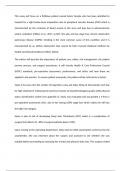This essay will focus on a fictitious patient named Sylvia Temple who has been admitted to
hospital for a right below knee amputation due to peripheral vascular disease (PVD) which is
characterised by the occlusion of blood vessels in the arms and legs due to atherosclerosis
and/or embolism (Clifton et al., 2017, p.649). She also and has stage four chronic obstructive
pulmonary disease (COPD); Smoking is the most common cause of this condition and it is
characterized by an airflow obstruction that cannot be fully reversed (National Institute for
Health and Clinical Excellence (NICE), (2010).
The author will describe the importance of patient care, safety, risk management, the patient
journey process, and surgical procedures. It will include Health & Care Professions Council
(HCPC) standards, pre-operative assessment, performance, and ethics and how these are
applied in the practice. To ensure patient anonymity, the patient will be referred to as Sylvia.
Sylvia is 62 years old. She smokes 30 cigarettes a day and takes 40mg of Atorvastatin each day
for high cholesterol. Following the American Society of Anaesthesiologists grades (ASA) physical
status classification system (see appendix 1), Sylvia was evaluated and was graded a 4 from a
pre-operative assessment clinic, due to her having COPD stage four which makes her fall into
the high-risk category.
Slyvia is also at risk of developing Deep Vein Thrombosis (DVT) which is a complication of
surgery that affects 10 - 80% of surgical patients (Davis 1999).
Upon arriving at the operating department, Sylvia had an initial examination carried out by the
anaesthetist. She was informed about her surgery and assessed to see whether she was
suitable before proceeding by assessing her mental and physical state also. The surgeon visited
, Sylvia in order to mark the operative site, to ensure that correct site surgery would occur, to
answer any additional questions and to obtain her signature as consenting to the procedure as
one of the five components from Beauchamp and Childress (2001). Providing high-quality care
and reducing hospital stay requirements were achieved through effective communication
between departments. The next step was to observe Sylvia's blood pressure, oxygen saturation,
pulse, and heart rate.
Before elective surgery, adults and children should drink clear fluids (like water, juices without
pulp, and black or decaf tea) up to 2 hours before surgery, and solids 6 hours beforehand as
stated by (Smith et al., 2011). Preoperatively, the patient was asked to stop smoking, as
smoking has an effect on the immune system. When smoking, the immune system experiences
several detrimental effects, including hampered enzyme production, decreased fibroblast,
macrophage, and red blood cell growth. Moller & Tonnesen (2006) indicates that wounds with
a delayed healing process are more likely to develop SSI’s (surgical site infections).
Before commencing treatment, the theatre team would prepare the theatre, ensuring the
anaesthetic machine is in full working order, correct instrument check, also ensuring correct
room temperature to prevent inadvertent hypothermia, assuring sterility of instruments and
tissues, which would be the responsibilities of the Operating Department. According to Harper
et al (2008) the common consequence of anaesthesia is perioperative hypothermia, measured
by the body's core temperature at 36.0°C. Temperatures in the ambient air are less of a factor
when warming equipment is used to maintain the body temperature of the patient. There is
high risk of postoperative cardiac events, ventricular tachycardia, blood loss, wound infections,
and decreased cognitive function due to delayed post-anaesthesia recovery time and




